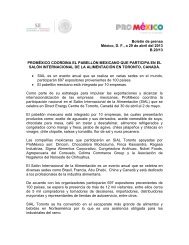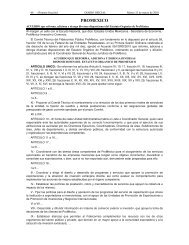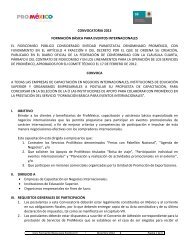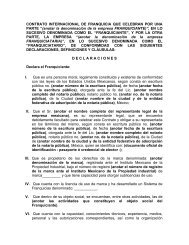ASiAn invASion wElcomEd - ProMéxico
ASiAn invASion wElcomEd - ProMéxico
ASiAn invASion wElcomEd - ProMéxico
You also want an ePaper? Increase the reach of your titles
YUMPU automatically turns print PDFs into web optimized ePapers that Google loves.
mexico’s partner lenovo<br />
lines of communication and is a great source<br />
of qualified workers,” he said.<br />
Besides its easy access to North and Latin<br />
American markets, Mexico was chosen for<br />
another very important reason. The Mexican<br />
market is –after Brazil– the biggest in<br />
Latin America for the personal computer<br />
industry.<br />
With an investment of 40 million usd,<br />
Lenovo’s plant in Monterrey is the company’s<br />
first manufacturing center on the American<br />
continent. It is located in a building that measures<br />
24,155 square meters and sits on an area<br />
that stretches over 6 hectares –leaving open<br />
the possibility for future expansion. The facility<br />
produces desktop computers, workstations,<br />
laptop computers and servers.<br />
The plant has an annual production capacity<br />
of 5 million units. Its activities include the<br />
manufacture and configuration of products,<br />
distribution with added value and customer<br />
service. It directly employs 1,450 people and<br />
is responsible for indirectly employing about<br />
another 1,000 from the region.<br />
A question of strategy<br />
At first, Lenovo Mexico’s most important<br />
clients were large global companies and government<br />
institutions. In the last few years,<br />
the company has aimed to broaden its market.<br />
“We are looking closely at medium and<br />
small companies that most of the time get<br />
their products from traditional distributors<br />
or from retail stores...And one of our biggest<br />
goals is to reach the consumer market, specifically<br />
the home sector,” Fernández said.<br />
But one of the peculiarities of the Mexican<br />
market is that many companies like to buy<br />
their products from retail stores where customers<br />
typically buy things for their homes:<br />
price clubs or office supply stores. Another<br />
distinctive characteristic of the national market<br />
is its preference for quality brands. Mexicans<br />
like buying brand name products.<br />
“The Mexican citizen looks for the best<br />
product –the brand name product– that he<br />
or she can afford to buy. It’s a characteristic<br />
trait that cannot be found with such intensity<br />
in any other Latin American market,”<br />
Fernández said.<br />
Facing the crisis<br />
Lenovo is dealing with the current financial<br />
crisis thanks to a worldwide restructuring,<br />
which is expected to help the company save<br />
up to 300 million usd during this fiscal year.<br />
In Mexico –where it values its pragmatic<br />
and frugal way of doing business– the company<br />
has focused on keeping all of its employees<br />
while it looks to efficiently capitalize on the opportunities<br />
the national market offers.<br />
“Our offer has contributed to the reduction<br />
of costs, not only in the price of acquisitions but<br />
also in the operation of equipment,” Fernández<br />
said. “Our way of buying machinery, our use<br />
of energy and heat generation and conservation<br />
is the most competitive in the market. In<br />
the long run, it reduces operation costs.” The<br />
company’s directive affirms that this has allowed<br />
Lenovo to navigate through the storm,<br />
continue capitalizing on opportunities and has<br />
let it move ahead. On a slow but firm pace, it<br />
continues with the intention of creating a long<br />
lasting brand in Mexico and the rest of the<br />
American continent.<br />
Local and global: a glance to the future<br />
Lenovo’s future is focused on two points:<br />
expansion on a national scale and assisting<br />
individual markets on a global scale.<br />
Lenovo Mexico is looking to build distribution<br />
and value chains through relationships<br />
with consultants, marketing agencies<br />
and software companies. This will allow the<br />
company to reach the entire country and all<br />
segments of the market.<br />
“It’s an expansion project so we can<br />
participate in market segments where we<br />
weren’t before,” Fernández said. “The first<br />
steps are modest but firm. We are sure that<br />
when the economy rebounds, we will be on<br />
the crest of a wave.”<br />
Worldwide, Lenovo has focused on two important<br />
market segments: emerging markets<br />
and developed ones like Canada, the United<br />
States and Europe. Countries like Mexico and<br />
Brazil make up a sui generis group, on horseback<br />
among many types of markets.<br />
“We have a special category and we have<br />
decided to invest in this segment,” Fernández<br />
said. n<br />
Lenovo’s Worldwide Sales<br />
(2008-2009 fiscal year, by region)<br />
China<br />
1.2 billion usd<br />
(43.6% of global sales)<br />
America<br />
682 million usd<br />
(24.6% of global sales)<br />
Europe, Middle East and Africa<br />
591 million usd<br />
(21.3% of global sales)<br />
Asia Pacific (excluding China)<br />
291 million usd<br />
(10.5% of global sales)

















